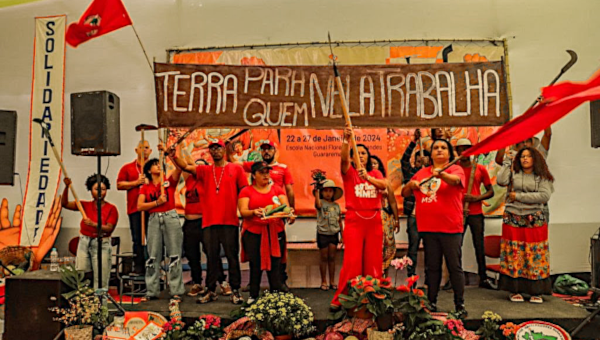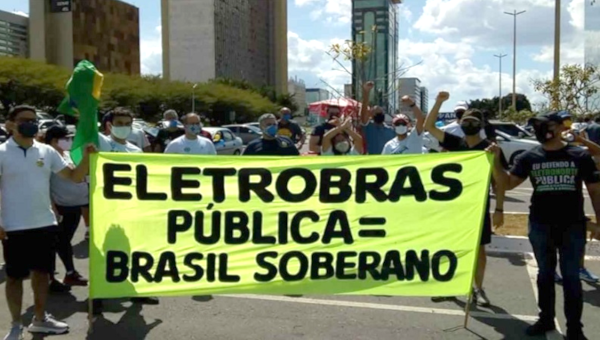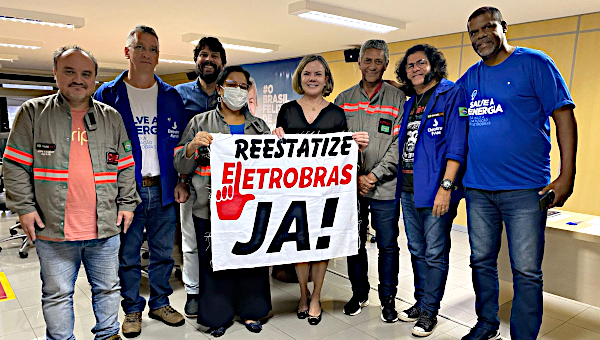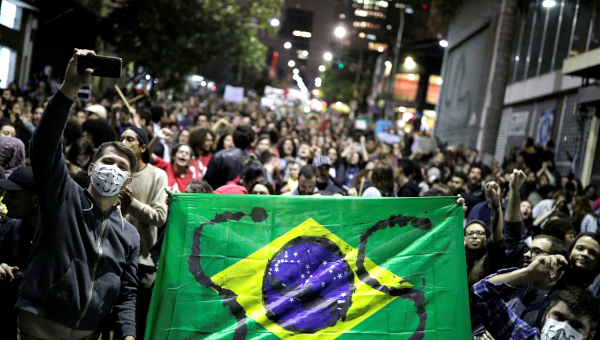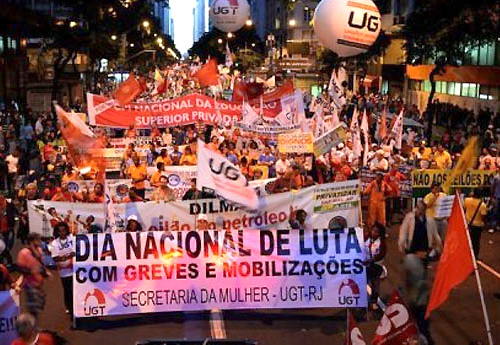
The mass movements starting in June 2013 were the largest and most significant protests in Brazil in a generation, and they have shaken up the country’s political system. Their explosive growth, size and extraordinary reach caught everyone – the left, the right, and the government – by surprise. This article examines these movements in light of the achievements and shortcomings of the democratic transition, in the mid-1980s, and the experience of the federal administrations led by the Workers’ Party since 2003.
A Summary of the Facts
On 6 June, the radical left Free Fare Movement (Movimento Passe Livre, MPL), an autonomist non-party organization that has been active in the country for several years led a small demonstration demanding the reversal of a recent increase in public transport fares in the city of São Paulo, from R$3 to R$3.20. The movement was criticized by the press for blocking the traffic and making unrealistic demands, and the demonstration was attacked by the police. The MPL returned in larger numbers in the following days, and the police responded with increasing brutality, beating up demonstrators and passers-by indiscriminately, and wounding several journalists.
In two weeks, the demonstrations had exploded in size while also spreading across the country. They attracted well over one million people in hundreds of cities, and movements are still taking place almost every day, including a large national mobilization led by the left on 11 July. They involve mainly young workers, students and the middle class, and localized movements of poor communities and categories of workers with demands that may be more or less specific to their circumstances (bus drivers, lorry drivers, health sector workers, and so on).
In mid-June, the mainstream press and TV networks suddenly changed sides, and started supporting the movement. They immediately engaged in a full-scale attempt to lead the movement, offering blanket coverage, effectively calling people to the streets, and – very importantly – sponsoring the multiplication and de-radicalization of demands, toward a cacophony focusing on broad citizenship issues and, especially, state inefficiency and corruption, in order to drown out the left and delegitimize the federal government.
From this moment on, the demonstrations became much more white and middle-class in composition. They included banners about a whole range of issues, among them public services (for); FIFA, the 2013 Confederations Cup and the 2014 World Cup (against); gay rights and the legalization of drugs (mainly for, but most churches are against); compulsory voting (mostly against); abortion and religious issues (all over the place); public spending, privatizations and the state monopolies (unclear); president Dilma Rousseff and the Workers’ Party (Partido dos Trabalhadores, or PT) (strongly against), the return of military rule (an ultra-right-wing pipe-dream), and, especially, corruption (against which everyone can happily march together). Anyone could come up with their own demand, and if they were individualist and anti-political this was even better TV. It was especially paradoxical to see middle class people expressing indignation over public services that they do not currently use, and have no intention of using any time soon.
In common with recent movements elsewhere, the Brazilian demonstrations were largely organized through social media and TV. Unusually, they often had no clear leaders and no speeches. Frequently, groups of people organized themselves on Facebook and Twitter, met somewhere, and then marched in directions that were frequently unclear, depending on decisions made by unknown persons more or less on the spot.
Police repression was sometimes accompanied by riots, and then the police pulled back, partly because of concerns with their public image; at other times, the police would attack the demonstrators while leaving the rioters alone. Infiltration by the police and the far-right was both evident and widespread. Some marches were, somehow, proclaimed to be ‘party-free,’ and left-wing militants and trade unionists were harassed and beaten up by thugs screaming ‘my party is my country.’ During this period, the mobilizations continued to grow; as they did so, they became both more radicalized and more fragmented. When the federal government finally pushed São Paulo and Rio de Janeiro to reverse the transport fare increases, by offering them tax breaks accompanied by the threat of leaving them alone to sort out the mess, the mobilizations were already out of control.
In late June, the left made a co-ordinated effort to regain leadership of the movement, while the presidency attempted to take the initiative from above with a call for political reform and initiatives to increase spending in public services and improve health provision. The demonstrations have subsequently dwindled in size, except for the large nationwide strike on 11 July.
Three Lessons
The first lesson from the movements is that they have confirmed the unremitting rejection of former president Lula da Silva, president Dilma Rousseff and the PT by large segments of the upper and middle classes, and the mainstream media. Their hatred, which has been displayed prominently in the marches and in the accompanying press coverage, is not due to narrow economic concerns. Lula has plausibly insisted that the Brazilian elite never made so much money as they did during his administration, and this may still hold true under Dilma. Nevertheless, fractions of the bourgeoisie and the middle classes resent their loss of privilege because of the expansion of citizenship since the democratization of the country and, especially, under the federal administrations led by the PT. To their profound irritation, the Brazilian elites have realized that they can no longer drive Brazilian politics alone.
The redistribution of income and the expansion of social programmes in the last ten years, marginal as they have been, have benefitted tens of millions of people, while consumer credit, perverse as it is, has allowed many poor people to visit shopping centres, fly across the country, and buy a small car. The left ought to criticize some of these aspirations, and point out that they may be socially undesirable, environmentally unsustainable, or both, that they have not been accompanied by the expanded provision of infrastructure, and that they were often promoted by the government in order to support large capital – but, at this point in time, they express the demands and aspirations of tens of millions of people. The result is that Brazilian roads and airports are full, and their previous (elite) users complain bitterly about the lack of space to accommodate all those poor people moving about, and now with a sense of entitlement.
While large capital did well economically in the last decade, and even longer, the middle class did not. So-called ‘good jobs’ in the private and public sectors are relatively scarce, higher education is no longer a guarantee of ‘good’ income, and the young find it hard to do better economically than their parents did. Middle class groups desperately want economic growth, but they remain ideologically attached to a neoliberal-globalist project which slows down growth. They are also frightened by the supposed ‘radicalism’ of the government, despite the PT’s extraordinary moderation, and terrified of Brazil becoming another Venezuela.
The second lesson from the protests is that, under favourable economic circumstances the ‘left neoliberal’ policies implemented by the PT, and the greater legitimacy of the state which has accompanied Lula’s election, can disarm the political right and disconnect the radical left from the masses of the population. Lula ended his second administration, in 2010, with approval rates touching on 90%, and Dilma Rousseff had 60-70% approval rates until recently, which had never happened to any Brazilian president in their third year in office. No party has ever prospered to the left of the PT and, until recently, the right-wing opposition was hopelessly disorganized. For a brief period, the PT achieved something close to political hegemony in Brazil. Now the PT and the country are locked in political confusion.
The third lesson is that the achievements of the PT administrations have raised expectations as well as incomes. The emerging poor want to consume more, larger masses of people want social inclusion, and both want better public services. The middle classes oscillate between indifference and open hostility to the poor, but would like to benefit from good public services at some point in the future. They are, however, absolutely opposed to paying higher taxes in order to have them. They claim that they pay too much already, that corruption spirits away a large chunk of the government’s revenues, and that ‘their’ taxes have been supporting a parasitic mass of undeserving poor through the federal transfer programmes. At the same time, the press and the middle class completely disregard the fact that nearly half of the federal budget is committed to servicing the domestic public debt – effectively a welfare programme for the rich – and that this dwarfs the cost of social spending and federal transfer programmes.
These enormous demands upon the state come in the wake of the decomposition of the traditional working-class and the demoralization and disorganization of the left parties and trade unions, after the transition to democracy, the transition to neoliberalism, and the elections of Lula and Dilma. Their outcome is that, while the middle class is confused, angry and disorganized, the workers are unhappy, mostly for different reasons, marginalized, and also disorganized. This is a recipe for political volatility, and it poses difficult problems for the left.
Left Dilemmas
Dilma Rousseff was elected president by Lula’s social base, mainly the poor, with the support of large capital. But Dilma had a limitation: she has always been a technocrat, had never been elected to public office, and did not have her own political base. Even worse, the economy was bound to decelerate during her administration, after the boom years in the mid-2000s, and Brazil’s extraordinarily successful bounce-back after the 2008 global crisis.
The economic slowdown would necessarily create social and political tensions because of existing dissatisfactions and conflicting aspirations, and the shrinking ability of the state to address them, for example, because the entire (broad) left controls less than one-third of seats in Congress. This makes it impossible for the PT to govern without alliances with undisciplined right-wing parties and unsavoury individuals, which have to be managed under the gaze of a relentlessly hostile press and the scrutiny of a right-wing judicial system.
The space to manage these contradictions has shrunk further in recent months. Inflation, the current account deficit and the fiscal deficit are rising, and the currency is falling because of the global decline in commodity prices, poor exports, growth slowdown in China, and capital outflows because of the unwinding of quantitative easing in the U.S., UK and the Eurozone. This has led the Central Bank of Brazil to raise interest rates, state-owned banks to cut lending, and the federal government and the state-owned enterprises to cut spending and public investment. The economy has stalled, and it has become difficult to continue to reduce inequality without directly hurting established privileges. These difficulties have been magnified by a relentless press campaign suggesting that the government is out of touch, that corruption is more prevalent than usual, and that the economy is out of control. Dilma’s approval in the opinion polls has plummeted.
Let us now return to the demonstrations. Although they had complex, overlapping and contradictory determinants, we can now identify four of their political implications.
“There is also a narrowing of ambition among this class, and a widespread rejection of collective aspirations to change society: their goals tend to be limited by the frame of reference imposed by neoliberalism.”
First, confusion, which has been intensified by the lack of organized working-class intervention. Under neoliberalism, the restructuring of capital has reconfigured the working-class, disabled its traditional mechanisms of representation, including trade unions, associations and left-wing parties, and largely destroyed the workers’ sense of collectivity. Brazil now has a working-class socialized under neoliberalism, atomized, inexperienced in collective action, attached to direct web-based communication, and reluctant to accept traditional mechanisms of representation, including parties and trade unions. There is also a narrowing of ambition among this class, and a widespread rejection of collective aspirations to change society: their goals tend to be limited by the frame of reference imposed by neoliberalism. This makes it difficult to articulate class demands and campaign effectively, both because the targets have become more diffuse under neoliberalism, and because the workers are predisposed against collective action.
Second, the protests express a confluence of dissatisfactions, including against the expansion of citizenship, which has squeezed the middle class and, on the part of the workers and the poor, demands for the further widening of citizenship, better public services and improved living conditions. Both groups also protest together, because of their perception of dysfunctionality and corruption in state institutions, which the right-wing press has highlighted with gusto, as if they were new and had been created by the PT. These contradictory demands could probably be managed if the Brazilian economy was growing, but it is not, which makes every grievance more urgent, and every constraint tighter.
Third, there is political confusion to the right of the government, and a political vacuum to the left.
Fourth, the common factor across most of the demands and dissatisfactions expressed in the June-July movement is the state – not just current state policy, but the structure of the Brazilian state. In this sense, whether implicitly or explicitly, the demonstrations are about controlling the state and, secondarily, controlling state policy.
If the movement were united, if it had a clear working-class character, and if it were led by left organizations, Brazil could be moving toward a revolutionary crisis. But this is not happening: there is no revolutionary party able to mobilize and lead the working-class, no perception that the state must no longer be dominated by bourgeois class interests, and no shared programme for social, economic and political transformation.
Summing Up
The protest movements in Brazil express deep frustrations and even despair, because it has become impossible to channel discontent through the traditional forms of social representation, which are either tightly controlled by the elite or have been disempowered by the neoliberal reforms. Yet, dissatisfaction without organization tends to be fruitless, and spontaneous mass movements with a mixed class base and fuelled by unfocused anger can be destabilizing without being constructive.
The need for organization, delegation of power and compromise within the movement and with outside institutions suggests that recomposing the working-class, and overcoming its material fragmentation and the cultural separations imposed by neoliberalism, requires collectivity in practice. This means talking and doing things together, more than interacting through web-based media. Twitter and Facebook are good ways to exchange discrete morsels of information, but they do not allow the exchange of ideas and the formation of bonds of trust.
The Brazilian left has reacted with maturity to the challenges posed by the protests and by the attempted kidnap of the movement by the mainstream media and the far-right. Left initiatives have been focusing on the convergence of sectional programmes, especially through common activities and a national co-ordination of movements, organizations and parties, to propose specific goals for the movement around political reform, the limitation of working hours, state investment in health, transport and education, the decommodification of public services, democratization of the media, and reform of the police. The point, now, is to identify platforms which can bring together the workers and the poor, marginalize and fragment the middle class and the right, and put pressure on the federal government, while allowing a radical working-class movement to work together with some state institutions in order to raise, from below, its influence over policy formulation and implementation.
The left ought to stick to this approach instead of falling into an infantile (and, fortunately, marginal) radicalism, targeting the federal government and, inevitably – because of their insufficient weight – joining in a subordinate position the destabilization campaign being led by the political right, the middle class, and the right-wing media. There is no doubt that left-wing administrations tend to implement more progressive policies and be more accommodating of mass movements than right-wing ones. If the current government lost coherence and became paralysed, this is extremely unlikely to foster a socialist revolution in Brazil, because there is no ideological, organizational, social, material or international basis for it to happen now. It would, instead, almost certainly facilitate a right-wing victory in the presidential elections next year, and contribute to the demoralization and disorganization of the Brazilian left.
The response of the federal government to the movements, after considerable hesitation, was precisely to seek left support, and propose a programme of political reforms and expansion of public service provision which could bring concrete gains to the workers and the poor. The left should engage in a dialogue with the government, while insisting that a predominantly parliamentary strategy to effect these Constitutional reforms is bound to fail. The government must, instead, align itself with the workers’ organizations and the left, in order to push through democratic reforms including state funding for the political parties, the break-up of the media monopolies, and improved education, health and public transport services.
It is disappointing, but also sobering, to conclude that Brazil is not going through a revolutionary crisis, and that the current political mobilizations are unlikely to trigger one. Nevertheless, this is unquestionably the most important social movement in Brazil in the last thirty years. The point, now, is to continue to fight on the streets, workplaces and schools, continue to broaden and radicalize the movement, bring out the working-class with its specific demands, defeat the right and disorganize and attract part of the middle classes, and push for progressive constitutional and policy changes. If this can be achieved, it would shift the political balance in the country, and it could lead to concrete long-term gains to the workers and the left in Brazil. •
Alfredo Saad Filho teaches in the Department of Development Studies at SOAS, University of London.


